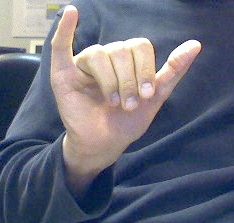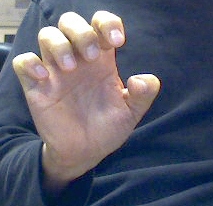Programming Assignment 2
Due Monday, February 28 at noon
This assignment will introduce you to 3D modeling and transformations
in OpenGL. You will develop a program that allows the user to control
a simulated human hand.
Get Some Files
Some basic functions and the hand simulator's main program are provided
for you. So, before you begin programming, you will need to download source
files:
Java programming
C/C++ programming
- Download PA2_C.zip -- source files, including templates for 3 subroutines you write
- Make sure that GLUT is
installed on your machine
This source code allows the shaded display of a simple ellipsoidal hand model.
You are expected to complete the program by modifying and extending
the source code to model a hand with all five fingers. There are comments
in the source files that can help guide you in writing your own subroutines.
You can also develop your own functions, and use additional source
files for your code if you like.
Run the Example Hand Animation Tool
An example of a fully functioning hand animation tool is available here. When asked how to handle this file, choose the java web start program
that came with the java jdk downloaded.
Program Interface
The user interface to the program is provided through mouse buttons and
keyboard:
- 1, 2, 3, 4, 5 keys: toggles which fingers' are
active for rotation (1=thumb, 5=pinky)
- P, M, D key: select which joint is active P=joint of finger
with palm, M=middle joint, D=last (distal) joint
- X, Y, Z: set current rotation axis to x, y, or z axis
- Up-arrow, down-arrow: change the angle at the active joints
- Left mouse button click and drag motion: change the viewing
angle
- R key: reset the viewing angle
- Q key: quit
The Code You Write
You are expected to write a program that will simulate a 3D hand
- Use OpenGL to construct a 3D hand model from cylinders
and/or ellipsoids. The
model need not be anatomically accurate. You can model the palm as
a single ellipsoid, assume the thumb has two joints, and the other four
fingers have three joints each. You can also assume that each joint
has two angular degrees of freedom.
- Write code that enables the user to change the angles at each finger
joint via the keyboard interface provided.
- Limit the angles at each joint within reasonable ranges so that fingers
don't bend in unnatural ways!
- Add a keyboard command 'C' that "clears" the hand angle state, resetting
the hand to standard position: hand posed in the "stop" pose.
- Add a keyboard command 'T' that cycles through test cases shown in
photographs below: "peace sign," "fist," "hang ten," "spread," and "claw."
Required for CS680 Students
In addition to the hand, model the upper-arm, lower-arm, and the wrist.
Be sure to model proper rotations at the shoulder and elbow.
Extra Credit
For extra credit, use texture mapping to apply a skin texture to the
model.
Test Cases
As mentioned above, you are to add a keyboard input 'T' which cycles
through test cases:

|

|

|
"stop"
|
"peace sign"
|
"fist"
|

|

|

|
"hang ten"
|
"spread"
|
"claw"
|
Demo
Part of your grade for this programming assignment will be based
on your giving a short demo (5 minutes) in the CS instruction laboratory.
You will be expected to talk about how your program works, and we will
see how well your program performs on the aforementioned test cases,
as well as some additional, surprise test examples. Demos will be scheduled
during the lab section meetings, after the due date. You
will be asked to sign up for a demo slot on a signup sheet that will
be circulated in class before the assignment due date.
Source Code Submission
Your program's source files are to be submitted electronically. Use
the gsubmit
program on the CS cluster.
The code you submit should conform with the program
assignment guidelines.
Grading (Out of 100 points)
CS480
| 3D hand model constructed of
ellipsoids |
25 points |
| Proper rotation at the joints |
25 points |
| Limit rotation so that fingers
do not bend in unnatural ways |
10 points |
| Test cases work properly |
30 points
|
| Programming style |
10 points |
| Texture mapping |
10 extra credit |
CS680
| 3D hand model constructed of
ellipsoids |
20 points |
| Proper rotation at the joints |
20 points |
| Limit rotation so that fingers
do not bend in unnatural ways |
10 points |
| Test cases work properly, even
when arm moves |
30 points |
| Arm angles work properly, attached
to hand |
20 points |
| Texture mapping |
10 extra credit |
Late Assignment Policy
Late programming projects and problem sets will be levied a late penalty
of 10% per day (up to three days). After three days, no credit will be given.
Collaboration/Academic Honesty
All undergraduate course participants must adhere to the CAS
Academic Conduct Code.
All graduate student course participants must adhere to the GRS
Academic Conduct Code.
All instances of academic dishonesty will be reported to the academic conduct
committee.











